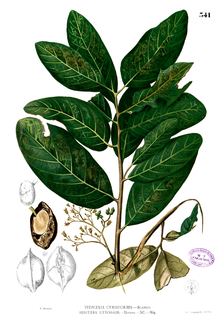Heritiera littoralis
You can help expand this article with text translated from the corresponding article in Japanese. (December 2012) Click [show] for important translation instructions.
|
| Heritiera littoralis | |
|---|---|

| |
| Scientific classification | |
| Kingdom: | Plantae |
| Clade: | Tracheophytes |
| Clade: | Angiosperms |
| Clade: | Eudicots |
| Clade: | Rosids |
| Order: | Malvales |
| Family: | Malvaceae |
| Genus: | Heritiera |
| Species: | H. littoralis
|
| Binomial name | |
| Heritiera littoralis | |
| Synonyms[2] | |
| |
Heritiera littoralis, the looking-glass mangrove is a large tree with wing shaped nuts, which is most easily recognised by the silvery scales on the underside of its leaves, which therefore appear green from top and white from below, although Litsea mellifera A.C. Smith (in the family Lauraceae), has the same type of leaves. The tree is usually found to grow along the seashore in South Asia, Southeast Asia and Tropical Africa.
The tree's tough wood has historically been used in boat-building.[3] The fruits of the tree (known as dungon locally), are also used in Philippine cuisine for kinilaw.[4]
Common names
Native names for the tree include:[5][6]
- Bengali – sundari (সুন্দরী, সুন্দরি)
- Bahasa Indonesia – dungun kecil, dungun laut
- Filipino – dungon
- Hindi – sundari (सुंदरी)
- Japanese – sakishimasuōnoki (サキシマスオウノキ)
- Kannada – chanda mara (ಚಂದ ಮರ)
- Malay – pokok dungun
- Malayalam – mukuram (മുകുരം)
- Marathi – sundari (सुंदरी)
- Odia – sundari (ସୁନ୍ଦରୀ)
- Sinhala – etuna (ඇටුන), ho mediriya (හෝ මැදිරිය)
- Tamil – conmuntiri (சொன்முந்திரி), cuntari (சுந்தரி)
- Tongan – mamaea
- Vietnamese – cui biển
- Visayan – dungon
- Maldivian – ކަހަރުވައް (kaharuvah)
- Chamorro - ufa
Uses
The tree is harvested for timber and is valued for its toughness, durability, and resistance to saltwater. As such, it is commonly used in shipbuilding and in making pilings, bridges, and wharves.[7]
The fruit of species in the genus is used in Philippine cuisine to neutralize the fishy taste in kinilaw, a local dish of raw fish in vinegar or citrus juices. Another species used this way is the fruits of the tabon-tabon tree (Atuna racemosa).[8][4]
Gallery
-
Fruit of Heritiera littoralis
-
Fruit of Heritiera littoralis in a mangrove in the Andamans.
References
- ^ Duke, N., Kathiresan, K., Salmo III, S.G., Fernando, E.S., Peras, J.R., Sukardjo, S. & Miyagi, T. 2010. Heritiera littoralis. In: IUCN 2011. IUCN Red List of Threatened Species. Version 2011.2. <www.iucnredlist.org>. Downloaded on 4 March 2012.
- ^ "Heritiera littoralis Aiton — the Plant List".
- ^ "Dungun (Heritiera littoralis) on the Shores of Singapore". WILD Fact Sheets. Retrieved 4 March 2012.
- ^ a b Mapa, Tata (5 July 2016). "Everything you need to know about kinilaw". waytogo. Retrieved 30 December 2018.
- ^ http://www.flowersofindia.net/catalog/slides/Looking%20Glass%20Mangrove.html
- ^ "Ayurvedic Plants of Sri Lanka: Plants Details". www.instituteofayurveda.org. Retrieved 4 August 2017.
- ^ "Dungon-late". NTFP Product Database. 24 February 2016. Retrieved 30 December 2018.
- ^ "Propagating the Dungon". RileyBulfa's Blog. 23 October 2013. Retrieved 30 December 2018.
![]() Media related to Heritiera littoralis at Wikimedia Commons
Media related to Heritiera littoralis at Wikimedia Commons





